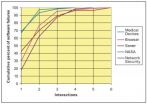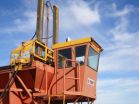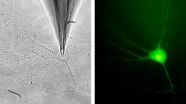(Press-News.org) New hemlock hybrids that are tolerant to the invasive insect known as hemlock woolly adelgid have been created by U.S. Department of Agriculture (USDA) scientists.
Geneticist Richard Olsen and horticulturist Sue Bentz of USDA's Agricultural Research Service (ARS) teamed up with Forest Service entomologist Mike Montgomery to breed and select these tolerant hybrids. Olsen and Bentz work in the U.S. National Arboretum's Floral and Nursery Plants Research Unit in Beltsville, Md. The arboretum is located in Washington, D.C., and is operated by ARS, the principal intramural scientific research agency of USDA.
Over the past few decades, two hemlocks native to the United States-Tsuga canadensis and Tsuga caroliniana-have been under attack by the small sucking insect Adelges tsugae, also known as the hemlock woolly adelgid (HWA). Originally from Asia, this aphid relative has spread to forests and backyards in 17 eastern states, killing hemlock trees and devastating natural ecosystems.
Under the direction of ARS geneticist Denny Townsend (now retired), the arboretum began a breeding program in the 1990s to develop hemlock hybrids tolerant to HWA. The scientists crossed hemlock species native to the United States with germplasm-collected in Asia-of hemlocks that have shown tolerance to the insect. Now, 10 years later, Olsen and Bentz have developed 140 hemlock hybrids, 108 of which are suitable for testing.
In 2006, Olsen and his colleagues began a multi-year field trial to test each hybrid's degree of tolerance to HWA. Testing more than 170 trees, the researchers artificially infested the hybrids by attaching HWA-infested branches to the hybrids' lower branches and securing them with mesh bags to prevent the insects from escaping. They found the species T. chinensis and its hybrids to be most tolerant to HWA.
Details of the scientists' studies have been published in the Journal of Economic Entomology, the Journal of Arboriculture and the Journal of the American Society for Horticultural Science.
The hybrids are appealing not only due to their tolerance, but because they have good vigor and shape. Still, the researchers have several years of testing to complete before they can release these hybrids.
INFORMATION:
Read more about this research in the November/December 2010 issue of Agricultural Research magazine.
USDA is an equal opportunity provider, employer and lender. To file a complaint of discrimination, write: USDA, Director, Office of Civil Rights, 1400 Independence Ave., S.W., Washington, D.C. 20250-9410 or call (800) 795-3272 (voice), or (202) 720-6382 (TDD).
END
Gone are the days when a doctor's only way of helping patients is by treating the disease after symptoms have started. Instead, a new approach to medicine, called "Desktop Medicine" is emerging, in which the emphasis shifts from diagnosing diseases and treating symptoms to identifying risk-factors for medical conditions such as hypertension and osteoporosis, and intervening before they develop. The commentary appears in the current issue of the Journal of the American Medical Association.
"Desktop medicine," a model defined by Jason Karlawish, MD, Associate Professor ...
By the end of this year, colonoscopy screening will have prevented bowel cancer in approximately 99 000 people since it was introduced in Germany. This is the result obtained by Hermann Brenner of the German Cancer Research Center in Heidelberg and his co-authors in their interim assessment conducted eight years after the procedure was added to the German cancer screening program. The authors present their projection and initial results of colonoscopy screening in Germany in the current edition of Deutsches Ärzteblatt International (Dtsch Arztebl Int 2010: 107(43): 753 ...
Researchers at the National Institute of Standards and Technology (NIST) have released an updated version of a computer system testing tool that can cut costs by more efficiently finding flaws. A tutorial on using the tool accompanies the new release.
Catching software "bugs" before a program is released enhances computer security because hackers often exploit these flaws to introduce malware, including viruses, to disrupt or take control of computer systems. But it's difficult. A widely cited 2002 study prepared for NIST* reported that even though 50 percent of software ...
A team of researchers from the University of Minnesota's College of Liberal Arts and College of Science and Engineering have found that an early part of the brain's visual system rewires itself when people are trained to perceive patterns, and have shown for the first time that this neural learning appears to be independent of higher order conscious visual processing.
The researchers' findings could help shape training programs for people who must learn to detect subtle patterns quickly, such as doctors reading X-rays or air traffic controllers monitoring radars. In addition, ...
National Institute of Standards and Technology (NIST) researchers have developed new certified reference materials for measuring amounts of organic acids in dietary supplements formulated with Vaccinium berries—cranberries, blueberries and bilberries. As described in a recent paper,* manufacturers and researchers can use this new suite of standard reference materialsTM (SRMs) as quality assurance tools.
berry SRMs
Dietary supplement manufacturers often include health claims on products made with Vaccinium berries. Suggested benefits include prevention of urinary tract ...
Many aspects of the German Genetic Diagnostics Act (Gendiagnostikgesetz) are out of touch with the latest technology, almost impossible to implement in clinical practice, or even detrimental to the success of recognised screening tests, such as newborn screening. The Act, which came into force in February 2010, is in desperate need of amendment. This was the conclusion reached by the Academy Workgroup "Predictive genetic diagnostics as an instrument of disease prevention" of the German Academy of Sciences Leopoldina, the Berlin-Brandenburg Academy of Sciences and Humanities ...
Using a neutron beam as a probe, researchers working at the National Institute of Standards and Technology (NIST) have begun to reveal the crystal structure of a compound essential to technologies ranging from sonar to computer memory. Their recent work* provides long-sought insight into just how a widely used material of modern technology actually works.
The compound is a "piezoelectric," a material capable of changing one kind of energy into another—mechanical to electrical, or vice versa. Long employed in sonar systems to detect sound waves, more recently piezoelectrics ...
VIDEO:
Wireless. For most, the word conjures images quaint coffee shops or busy airport lobbies -- places where people drop in to check on business or check in with other people.
But...
Click here for more information.
BEAUMONT – Wireless. For most, the word conjures images quaint coffee shops or busy airport lobbies – places where people drop in to check on business or check in with other people.
But increasingly "wireless" is showing up on the farm to help produce better ...
The researchers characterize their new technique as a neat solution to the "needle in a haystack" problem of nanoscale microscopy, but it's more like the difference between finding the coffee table in a darkened room either by walking around until you fall over it, or using a flashlight. In a new paper,* a group from JILA—a joint venture of the National Institute of Standards and Technology (NIST) and the University of Colorado—finds tiny assemblies of biomolecules for subsequent detailed imaging by combining precision laser optics with atomic force microscopy.
The ...
Neurons communicate via chemical transmitters which they store in the bubble-like synaptic vesicles and release as required. To be able to react reliably to stimulation, neurons must have a certain number of "acutely releasable" vesicles. With the help of a new method, neuroscientists at the Max Planck Institute of Experimental Medicine in Göttingen have now discovered that neurons systematically recycle the protein components necessary for transmitter release and in this way guarantee the reliability of signal transmission in the brain. If this process is disrupted, the ...




